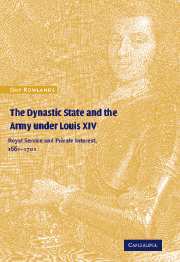Book contents
- Frontmatter
- Contents
- List of maps
- Acknowledgements
- List of abbreviations
- Family tree of the Le Tellier: 1. Principal branch
- Family tree of the Le Tellier: 2. Royal household marital connections
- Map 1 The French provinces under Louis XIV
- General introduction: ‘Absolute monarchy’, dynasticism and the standing army
- Part I ‘Patrimonial bureaucracy’: The Le Tellier dynasty and the Ministry of War
- Part II The forging of the French officer corps and the standing army under Louis XIV
- Introduction
- 6 In the name of sustainability: reforming the structure of the standing army and the officer corps
- 7 The business of a regiment
- 8 The pressures and temptations of service
- Part III The high command of the French armies
- Conclusion: The preservation of the dynasty
- Appendix 1 Defining the grands
- Appendix 2 The proportion of revenue generated by the Extraordinaire des Guerres as a ‘primary receiver’
- Bibliography
- Index
- CAMBRIDGE STUDIES IN EARLY MODERN HISTORY
Introduction
Published online by Cambridge University Press: 20 May 2010
- Frontmatter
- Contents
- List of maps
- Acknowledgements
- List of abbreviations
- Family tree of the Le Tellier: 1. Principal branch
- Family tree of the Le Tellier: 2. Royal household marital connections
- Map 1 The French provinces under Louis XIV
- General introduction: ‘Absolute monarchy’, dynasticism and the standing army
- Part I ‘Patrimonial bureaucracy’: The Le Tellier dynasty and the Ministry of War
- Part II The forging of the French officer corps and the standing army under Louis XIV
- Introduction
- 6 In the name of sustainability: reforming the structure of the standing army and the officer corps
- 7 The business of a regiment
- 8 The pressures and temptations of service
- Part III The high command of the French armies
- Conclusion: The preservation of the dynasty
- Appendix 1 Defining the grands
- Appendix 2 The proportion of revenue generated by the Extraordinaire des Guerres as a ‘primary receiver’
- Bibliography
- Index
- CAMBRIDGE STUDIES IN EARLY MODERN HISTORY
Summary
The French infantry used to be the worst in Europe, and has become the best mainly by the improvement in their officer material.
(Don Íñigo Fernández de Velasco y Tovar, Constable of Castile, Seventh Duke of Frías, 1684)By 1688 the French army was without question better organised, better disciplined and considerably larger than it had been during the reign of Louis XIII and the ministry of Cardinal Mazarin. French generals on attachment to foreign armies found them woefully deficient by comparison with their own. Nevertheless, this comparative advantage has tended to obscure the very real problems of military administration faced by Louis XIV and his ministers, not least in their attempts to organise and direct campaigning in more distant theatres of war. Furthermore, one must recognise that if the system of regimental administration was a distinct improvement upon the first half of the seventeenth century it came in for heavy criticism both from contemporaries and from reformers in the mid-eighteenth.
The key to a larger and better army lies only in part in the improvement in civilian administration, as demonstrated in part I of this book. To present a full picture one must consider the quotation at the beginning of this introduction.
- Type
- Chapter
- Information
- The Dynastic State and the Army under Louis XIVRoyal Service and Private Interest 1661–1701, pp. 153 - 160Publisher: Cambridge University PressPrint publication year: 2002

